Strategic Management: Jack Welch's Leadership at General Electric
VerifiedAdded on 2024/05/31
|16
|3866
|101
Report
AI Summary
This report provides a comprehensive analysis of leadership styles and strategic management at General Electric (GE), focusing on the impact of Jack Welch's leadership. It details Welch's approaches, including setting goals, communicating visions, and empowering employees, and their effects on GE's performance. The report explores various leadership theories such as autocratic, democratic, charismatic, transformational, and transactional leadership, relating them to Welch's methods. It further discusses organizational changes implemented at GE to enhance market share and efficiency, evaluating the efficacy of these strategies and offering recommendations for future improvements. Desklib provides similar solved assignments and past papers for students.
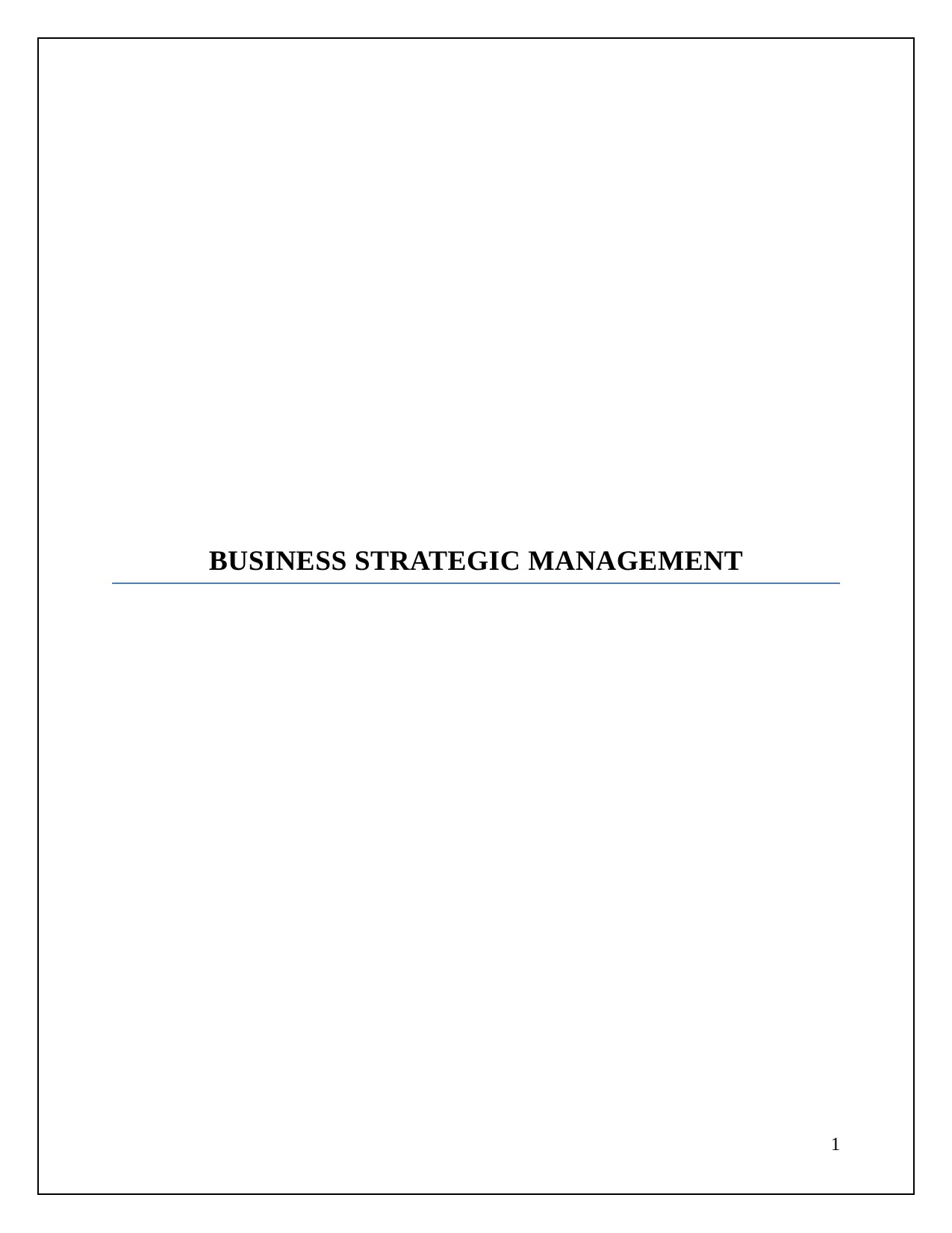
BUSINESS STRATEGIC MANAGEMENT
1
1
Paraphrase This Document
Need a fresh take? Get an instant paraphrase of this document with our AI Paraphraser
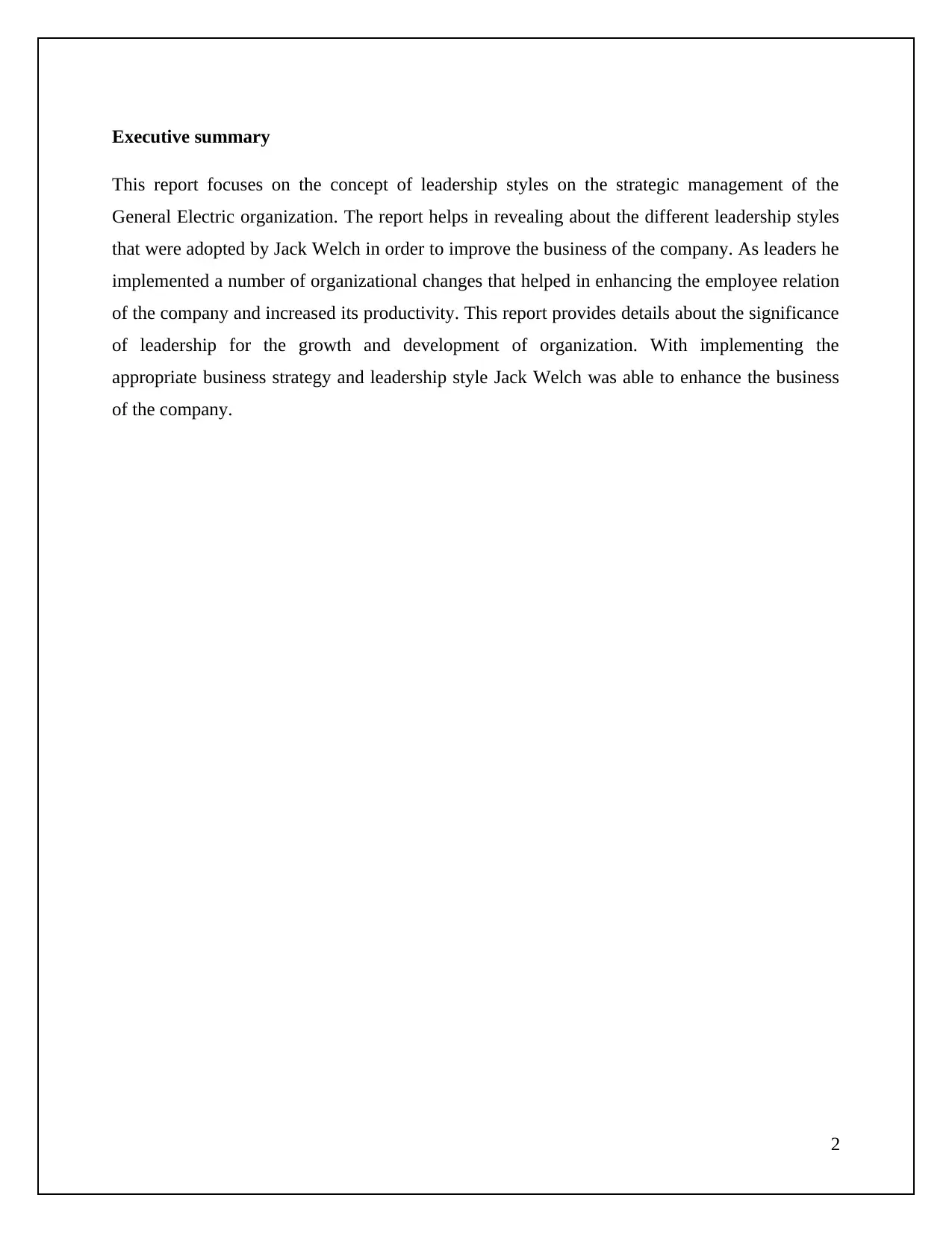
Executive summary
This report focuses on the concept of leadership styles on the strategic management of the
General Electric organization. The report helps in revealing about the different leadership styles
that were adopted by Jack Welch in order to improve the business of the company. As leaders he
implemented a number of organizational changes that helped in enhancing the employee relation
of the company and increased its productivity. This report provides details about the significance
of leadership for the growth and development of organization. With implementing the
appropriate business strategy and leadership style Jack Welch was able to enhance the business
of the company.
2
This report focuses on the concept of leadership styles on the strategic management of the
General Electric organization. The report helps in revealing about the different leadership styles
that were adopted by Jack Welch in order to improve the business of the company. As leaders he
implemented a number of organizational changes that helped in enhancing the employee relation
of the company and increased its productivity. This report provides details about the significance
of leadership for the growth and development of organization. With implementing the
appropriate business strategy and leadership style Jack Welch was able to enhance the business
of the company.
2
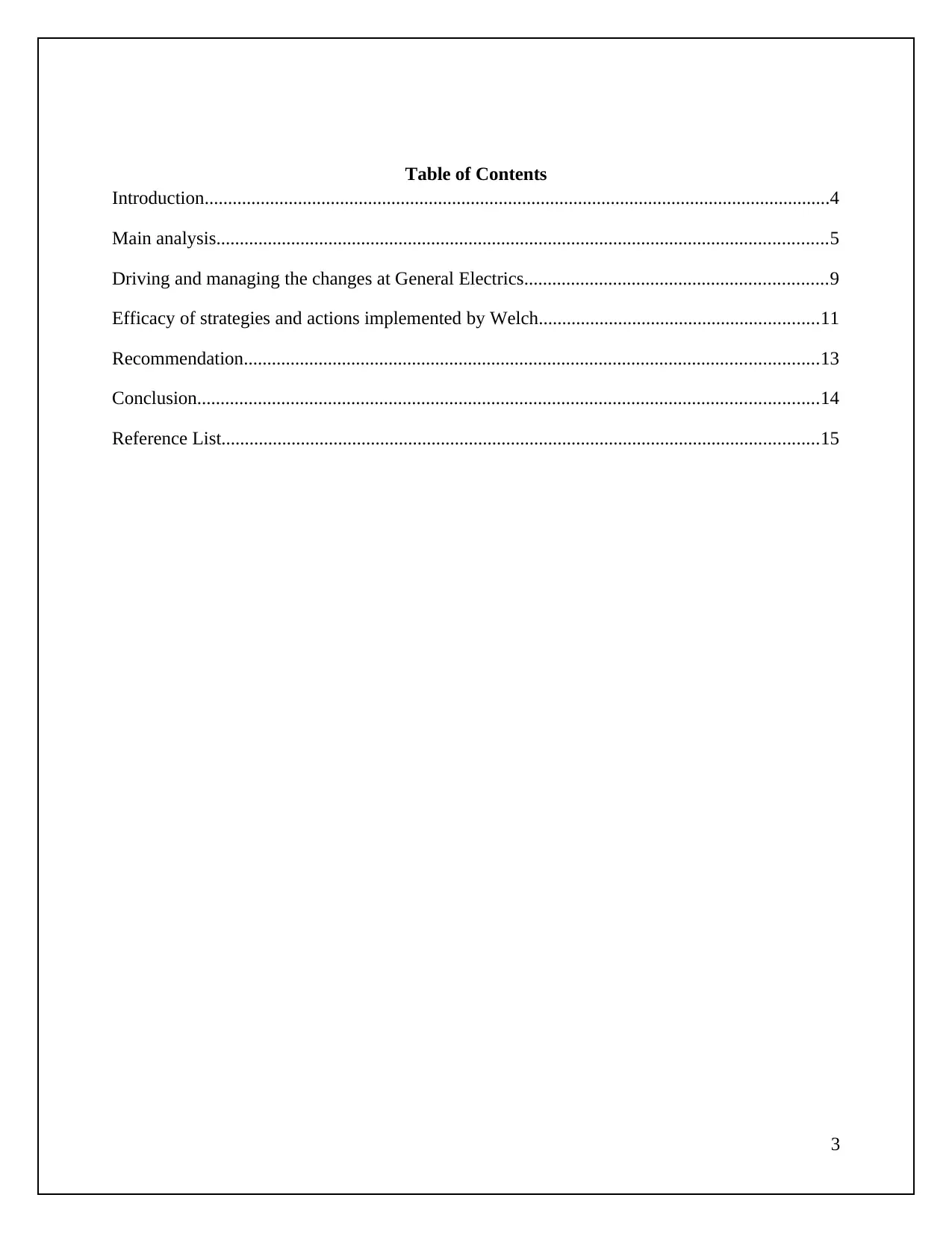
Table of Contents
Introduction......................................................................................................................................4
Main analysis...................................................................................................................................5
Driving and managing the changes at General Electrics.................................................................9
Efficacy of strategies and actions implemented by Welch............................................................11
Recommendation...........................................................................................................................13
Conclusion.....................................................................................................................................14
Reference List................................................................................................................................15
3
Introduction......................................................................................................................................4
Main analysis...................................................................................................................................5
Driving and managing the changes at General Electrics.................................................................9
Efficacy of strategies and actions implemented by Welch............................................................11
Recommendation...........................................................................................................................13
Conclusion.....................................................................................................................................14
Reference List................................................................................................................................15
3
⊘ This is a preview!⊘
Do you want full access?
Subscribe today to unlock all pages.

Trusted by 1+ million students worldwide

Introduction
Strategic management is necessary for the growth and development of business organization. it
helps in achieving the objectives and goals of a business firm. It is based on the assessment of a
number of resources and influence of policies on the business environment of the company. In
order to maximize the profit revenue private firm apply a number dynamic business strategy.
This report provides details about the strategic management analysis of General Electric (GE).
This company operated under the leadership of its CEO and chairperson John Francis “Jack
Welch Jr.” the leadership approaches used by the organization is based on strategic approaches
including empowering employees, setting goals, and effective communication.
Company overview
General Electric is an American organization that has their headquarters based in Boston,
Massachusetts. this company is operational in a number of segments such as Healthcare, Global
research, Aviation, Definable energy connections, power, gas, oil, transportation, renewable
energy, capital investment and lighting that helps in enhancing business of different industries. In
the list of Fortune 500 companies for the 2017 General Electric was able to secure 13th position
(Fortune.com, 2018).
4
Strategic management is necessary for the growth and development of business organization. it
helps in achieving the objectives and goals of a business firm. It is based on the assessment of a
number of resources and influence of policies on the business environment of the company. In
order to maximize the profit revenue private firm apply a number dynamic business strategy.
This report provides details about the strategic management analysis of General Electric (GE).
This company operated under the leadership of its CEO and chairperson John Francis “Jack
Welch Jr.” the leadership approaches used by the organization is based on strategic approaches
including empowering employees, setting goals, and effective communication.
Company overview
General Electric is an American organization that has their headquarters based in Boston,
Massachusetts. this company is operational in a number of segments such as Healthcare, Global
research, Aviation, Definable energy connections, power, gas, oil, transportation, renewable
energy, capital investment and lighting that helps in enhancing business of different industries. In
the list of Fortune 500 companies for the 2017 General Electric was able to secure 13th position
(Fortune.com, 2018).
4
Paraphrase This Document
Need a fresh take? Get an instant paraphrase of this document with our AI Paraphraser
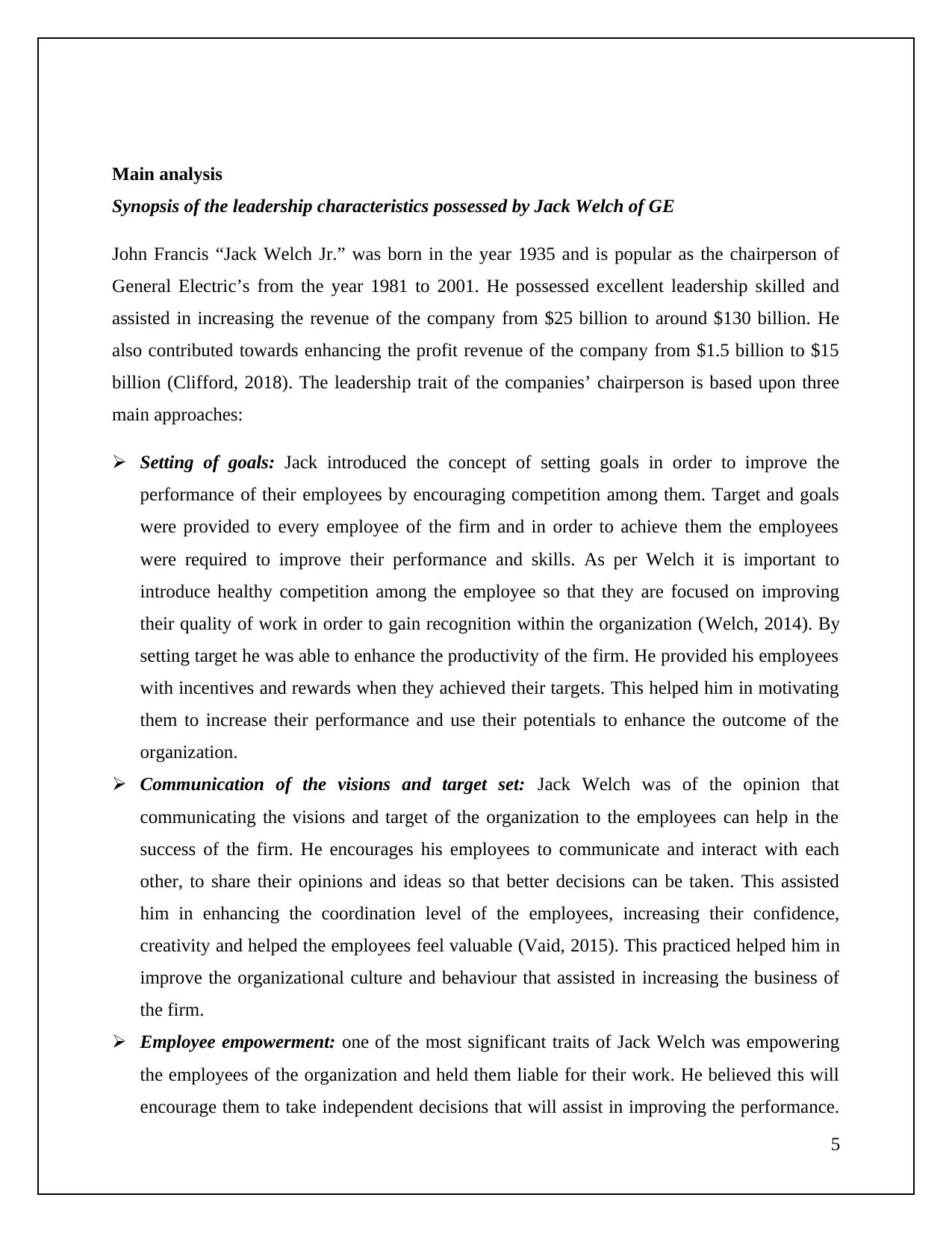
Main analysis
Synopsis of the leadership characteristics possessed by Jack Welch of GE
John Francis “Jack Welch Jr.” was born in the year 1935 and is popular as the chairperson of
General Electric’s from the year 1981 to 2001. He possessed excellent leadership skilled and
assisted in increasing the revenue of the company from $25 billion to around $130 billion. He
also contributed towards enhancing the profit revenue of the company from $1.5 billion to $15
billion (Clifford, 2018). The leadership trait of the companies’ chairperson is based upon three
main approaches:
Setting of goals: Jack introduced the concept of setting goals in order to improve the
performance of their employees by encouraging competition among them. Target and goals
were provided to every employee of the firm and in order to achieve them the employees
were required to improve their performance and skills. As per Welch it is important to
introduce healthy competition among the employee so that they are focused on improving
their quality of work in order to gain recognition within the organization (Welch, 2014). By
setting target he was able to enhance the productivity of the firm. He provided his employees
with incentives and rewards when they achieved their targets. This helped him in motivating
them to increase their performance and use their potentials to enhance the outcome of the
organization.
Communication of the visions and target set: Jack Welch was of the opinion that
communicating the visions and target of the organization to the employees can help in the
success of the firm. He encourages his employees to communicate and interact with each
other, to share their opinions and ideas so that better decisions can be taken. This assisted
him in enhancing the coordination level of the employees, increasing their confidence,
creativity and helped the employees feel valuable (Vaid, 2015). This practiced helped him in
improve the organizational culture and behaviour that assisted in increasing the business of
the firm.
Employee empowerment: one of the most significant traits of Jack Welch was empowering
the employees of the organization and held them liable for their work. He believed this will
encourage them to take independent decisions that will assist in improving the performance.
5
Synopsis of the leadership characteristics possessed by Jack Welch of GE
John Francis “Jack Welch Jr.” was born in the year 1935 and is popular as the chairperson of
General Electric’s from the year 1981 to 2001. He possessed excellent leadership skilled and
assisted in increasing the revenue of the company from $25 billion to around $130 billion. He
also contributed towards enhancing the profit revenue of the company from $1.5 billion to $15
billion (Clifford, 2018). The leadership trait of the companies’ chairperson is based upon three
main approaches:
Setting of goals: Jack introduced the concept of setting goals in order to improve the
performance of their employees by encouraging competition among them. Target and goals
were provided to every employee of the firm and in order to achieve them the employees
were required to improve their performance and skills. As per Welch it is important to
introduce healthy competition among the employee so that they are focused on improving
their quality of work in order to gain recognition within the organization (Welch, 2014). By
setting target he was able to enhance the productivity of the firm. He provided his employees
with incentives and rewards when they achieved their targets. This helped him in motivating
them to increase their performance and use their potentials to enhance the outcome of the
organization.
Communication of the visions and target set: Jack Welch was of the opinion that
communicating the visions and target of the organization to the employees can help in the
success of the firm. He encourages his employees to communicate and interact with each
other, to share their opinions and ideas so that better decisions can be taken. This assisted
him in enhancing the coordination level of the employees, increasing their confidence,
creativity and helped the employees feel valuable (Vaid, 2015). This practiced helped him in
improve the organizational culture and behaviour that assisted in increasing the business of
the firm.
Employee empowerment: one of the most significant traits of Jack Welch was empowering
the employees of the organization and held them liable for their work. He believed this will
encourage them to take independent decisions that will assist in improving the performance.
5

Liberation is vital for increasing the efficiency and performance of workforce. Jack identified
that GE has around nine levels in the hierarchy of their business management. Due to this
there were a number of issues in the organization such as unresponsive bureaucracy,
communication gap, and more. The employees were also not very independent and their
opinions were not given many values. In order to eliminate the issue he tried to eradicate the
excess layers of the management system. Jack allowed the employees to take responsibilities
of their duty and helped then in making better business decision that will be beneficial for the
company. As a result of this trait the productivity of the company enhances. Employees
became more creative, responsible, hard working and took beneficial decision that assisted
them in enhancing their performance.
The approaches that have been applied by Welch help in revealing the following aspects about
his leadership:
Welch believed in leading, as per him leaders are responsible to guide and lead their
subordinates. They are required to contribute to the company by forming goals, brining new
ideas, encouraging employees. The leader must give importance to the opinions of their
employees and take their suggestions into consideration.
Welch did not have faith in being formal with his employees and thus, he conducted
informal meeting where the employees were free to talk about their issues and ideas. This
was helpful for brining changes in organization that helped in increasing the business
(Antonakis and Day, 2017).
He believed in factual knowledge and reality rather than assuming conclusions. This helped
him in avoiding false scenarios and allowed him to take advantage of the available
opportunity.
Jack always motivated his staff members to work against the bureaucratic ways, as he
believes it slows down their activity due to unnecessary approvals. Employees were always
motivated to halt their unimportant work and coordinate with their superiors and teammates
in order to take beneficial decisions for the company. They were allowed to follow informal
communication and participate in important decision making processes.
6
that GE has around nine levels in the hierarchy of their business management. Due to this
there were a number of issues in the organization such as unresponsive bureaucracy,
communication gap, and more. The employees were also not very independent and their
opinions were not given many values. In order to eliminate the issue he tried to eradicate the
excess layers of the management system. Jack allowed the employees to take responsibilities
of their duty and helped then in making better business decision that will be beneficial for the
company. As a result of this trait the productivity of the company enhances. Employees
became more creative, responsible, hard working and took beneficial decision that assisted
them in enhancing their performance.
The approaches that have been applied by Welch help in revealing the following aspects about
his leadership:
Welch believed in leading, as per him leaders are responsible to guide and lead their
subordinates. They are required to contribute to the company by forming goals, brining new
ideas, encouraging employees. The leader must give importance to the opinions of their
employees and take their suggestions into consideration.
Welch did not have faith in being formal with his employees and thus, he conducted
informal meeting where the employees were free to talk about their issues and ideas. This
was helpful for brining changes in organization that helped in increasing the business
(Antonakis and Day, 2017).
He believed in factual knowledge and reality rather than assuming conclusions. This helped
him in avoiding false scenarios and allowed him to take advantage of the available
opportunity.
Jack always motivated his staff members to work against the bureaucratic ways, as he
believes it slows down their activity due to unnecessary approvals. Employees were always
motivated to halt their unimportant work and coordinate with their superiors and teammates
in order to take beneficial decisions for the company. They were allowed to follow informal
communication and participate in important decision making processes.
6
⊘ This is a preview!⊘
Do you want full access?
Subscribe today to unlock all pages.

Trusted by 1+ million students worldwide
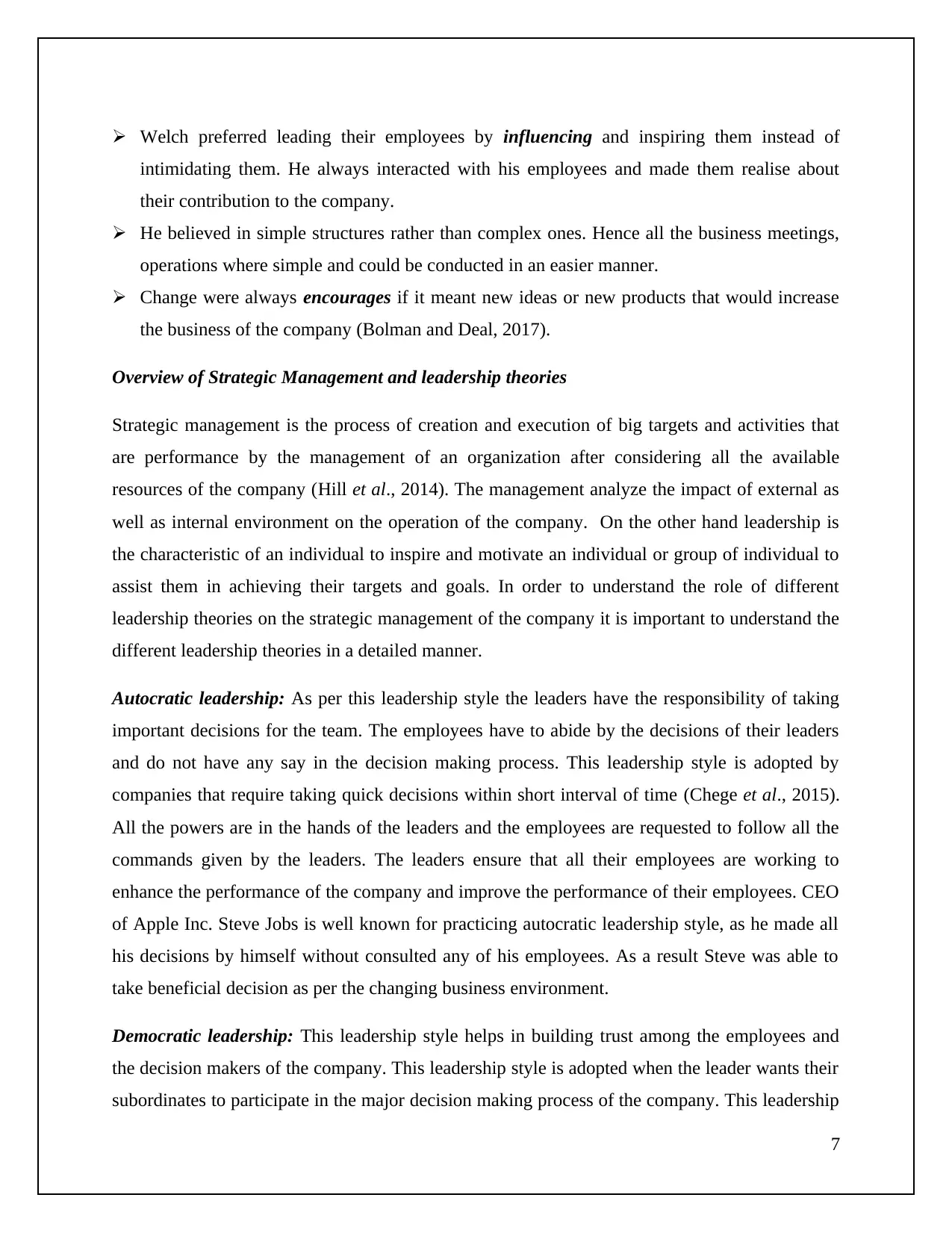
Welch preferred leading their employees by influencing and inspiring them instead of
intimidating them. He always interacted with his employees and made them realise about
their contribution to the company.
He believed in simple structures rather than complex ones. Hence all the business meetings,
operations where simple and could be conducted in an easier manner.
Change were always encourages if it meant new ideas or new products that would increase
the business of the company (Bolman and Deal, 2017).
Overview of Strategic Management and leadership theories
Strategic management is the process of creation and execution of big targets and activities that
are performance by the management of an organization after considering all the available
resources of the company (Hill et al., 2014). The management analyze the impact of external as
well as internal environment on the operation of the company. On the other hand leadership is
the characteristic of an individual to inspire and motivate an individual or group of individual to
assist them in achieving their targets and goals. In order to understand the role of different
leadership theories on the strategic management of the company it is important to understand the
different leadership theories in a detailed manner.
Autocratic leadership: As per this leadership style the leaders have the responsibility of taking
important decisions for the team. The employees have to abide by the decisions of their leaders
and do not have any say in the decision making process. This leadership style is adopted by
companies that require taking quick decisions within short interval of time (Chege et al., 2015).
All the powers are in the hands of the leaders and the employees are requested to follow all the
commands given by the leaders. The leaders ensure that all their employees are working to
enhance the performance of the company and improve the performance of their employees. CEO
of Apple Inc. Steve Jobs is well known for practicing autocratic leadership style, as he made all
his decisions by himself without consulted any of his employees. As a result Steve was able to
take beneficial decision as per the changing business environment.
Democratic leadership: This leadership style helps in building trust among the employees and
the decision makers of the company. This leadership style is adopted when the leader wants their
subordinates to participate in the major decision making process of the company. This leadership
7
intimidating them. He always interacted with his employees and made them realise about
their contribution to the company.
He believed in simple structures rather than complex ones. Hence all the business meetings,
operations where simple and could be conducted in an easier manner.
Change were always encourages if it meant new ideas or new products that would increase
the business of the company (Bolman and Deal, 2017).
Overview of Strategic Management and leadership theories
Strategic management is the process of creation and execution of big targets and activities that
are performance by the management of an organization after considering all the available
resources of the company (Hill et al., 2014). The management analyze the impact of external as
well as internal environment on the operation of the company. On the other hand leadership is
the characteristic of an individual to inspire and motivate an individual or group of individual to
assist them in achieving their targets and goals. In order to understand the role of different
leadership theories on the strategic management of the company it is important to understand the
different leadership theories in a detailed manner.
Autocratic leadership: As per this leadership style the leaders have the responsibility of taking
important decisions for the team. The employees have to abide by the decisions of their leaders
and do not have any say in the decision making process. This leadership style is adopted by
companies that require taking quick decisions within short interval of time (Chege et al., 2015).
All the powers are in the hands of the leaders and the employees are requested to follow all the
commands given by the leaders. The leaders ensure that all their employees are working to
enhance the performance of the company and improve the performance of their employees. CEO
of Apple Inc. Steve Jobs is well known for practicing autocratic leadership style, as he made all
his decisions by himself without consulted any of his employees. As a result Steve was able to
take beneficial decision as per the changing business environment.
Democratic leadership: This leadership style helps in building trust among the employees and
the decision makers of the company. This leadership style is adopted when the leader wants their
subordinates to participate in the major decision making process of the company. This leadership
7
Paraphrase This Document
Need a fresh take? Get an instant paraphrase of this document with our AI Paraphraser
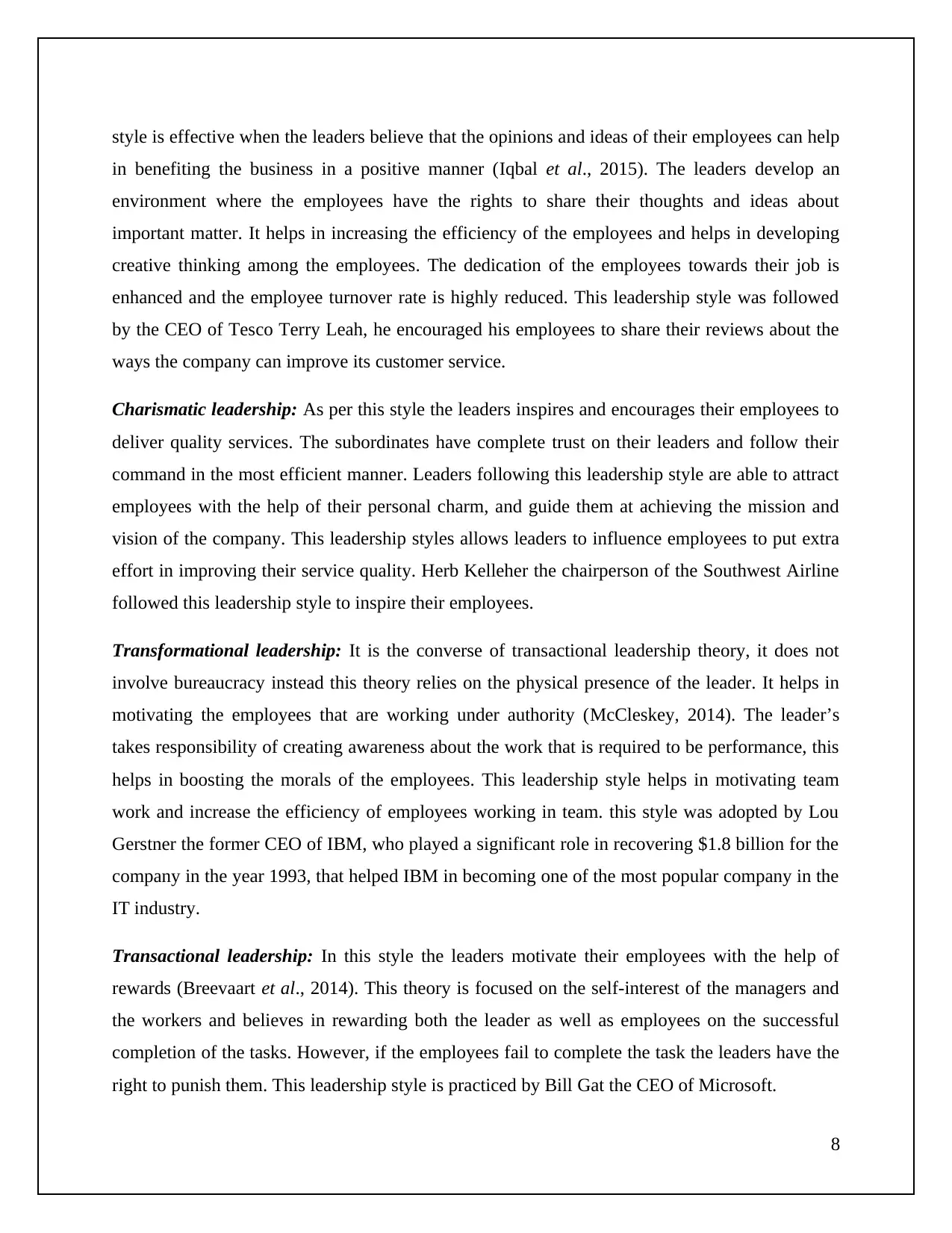
style is effective when the leaders believe that the opinions and ideas of their employees can help
in benefiting the business in a positive manner (Iqbal et al., 2015). The leaders develop an
environment where the employees have the rights to share their thoughts and ideas about
important matter. It helps in increasing the efficiency of the employees and helps in developing
creative thinking among the employees. The dedication of the employees towards their job is
enhanced and the employee turnover rate is highly reduced. This leadership style was followed
by the CEO of Tesco Terry Leah, he encouraged his employees to share their reviews about the
ways the company can improve its customer service.
Charismatic leadership: As per this style the leaders inspires and encourages their employees to
deliver quality services. The subordinates have complete trust on their leaders and follow their
command in the most efficient manner. Leaders following this leadership style are able to attract
employees with the help of their personal charm, and guide them at achieving the mission and
vision of the company. This leadership styles allows leaders to influence employees to put extra
effort in improving their service quality. Herb Kelleher the chairperson of the Southwest Airline
followed this leadership style to inspire their employees.
Transformational leadership: It is the converse of transactional leadership theory, it does not
involve bureaucracy instead this theory relies on the physical presence of the leader. It helps in
motivating the employees that are working under authority (McCleskey, 2014). The leader’s
takes responsibility of creating awareness about the work that is required to be performance, this
helps in boosting the morals of the employees. This leadership style helps in motivating team
work and increase the efficiency of employees working in team. this style was adopted by Lou
Gerstner the former CEO of IBM, who played a significant role in recovering $1.8 billion for the
company in the year 1993, that helped IBM in becoming one of the most popular company in the
IT industry.
Transactional leadership: In this style the leaders motivate their employees with the help of
rewards (Breevaart et al., 2014). This theory is focused on the self-interest of the managers and
the workers and believes in rewarding both the leader as well as employees on the successful
completion of the tasks. However, if the employees fail to complete the task the leaders have the
right to punish them. This leadership style is practiced by Bill Gat the CEO of Microsoft.
8
in benefiting the business in a positive manner (Iqbal et al., 2015). The leaders develop an
environment where the employees have the rights to share their thoughts and ideas about
important matter. It helps in increasing the efficiency of the employees and helps in developing
creative thinking among the employees. The dedication of the employees towards their job is
enhanced and the employee turnover rate is highly reduced. This leadership style was followed
by the CEO of Tesco Terry Leah, he encouraged his employees to share their reviews about the
ways the company can improve its customer service.
Charismatic leadership: As per this style the leaders inspires and encourages their employees to
deliver quality services. The subordinates have complete trust on their leaders and follow their
command in the most efficient manner. Leaders following this leadership style are able to attract
employees with the help of their personal charm, and guide them at achieving the mission and
vision of the company. This leadership styles allows leaders to influence employees to put extra
effort in improving their service quality. Herb Kelleher the chairperson of the Southwest Airline
followed this leadership style to inspire their employees.
Transformational leadership: It is the converse of transactional leadership theory, it does not
involve bureaucracy instead this theory relies on the physical presence of the leader. It helps in
motivating the employees that are working under authority (McCleskey, 2014). The leader’s
takes responsibility of creating awareness about the work that is required to be performance, this
helps in boosting the morals of the employees. This leadership style helps in motivating team
work and increase the efficiency of employees working in team. this style was adopted by Lou
Gerstner the former CEO of IBM, who played a significant role in recovering $1.8 billion for the
company in the year 1993, that helped IBM in becoming one of the most popular company in the
IT industry.
Transactional leadership: In this style the leaders motivate their employees with the help of
rewards (Breevaart et al., 2014). This theory is focused on the self-interest of the managers and
the workers and believes in rewarding both the leader as well as employees on the successful
completion of the tasks. However, if the employees fail to complete the task the leaders have the
right to punish them. This leadership style is practiced by Bill Gat the CEO of Microsoft.
8
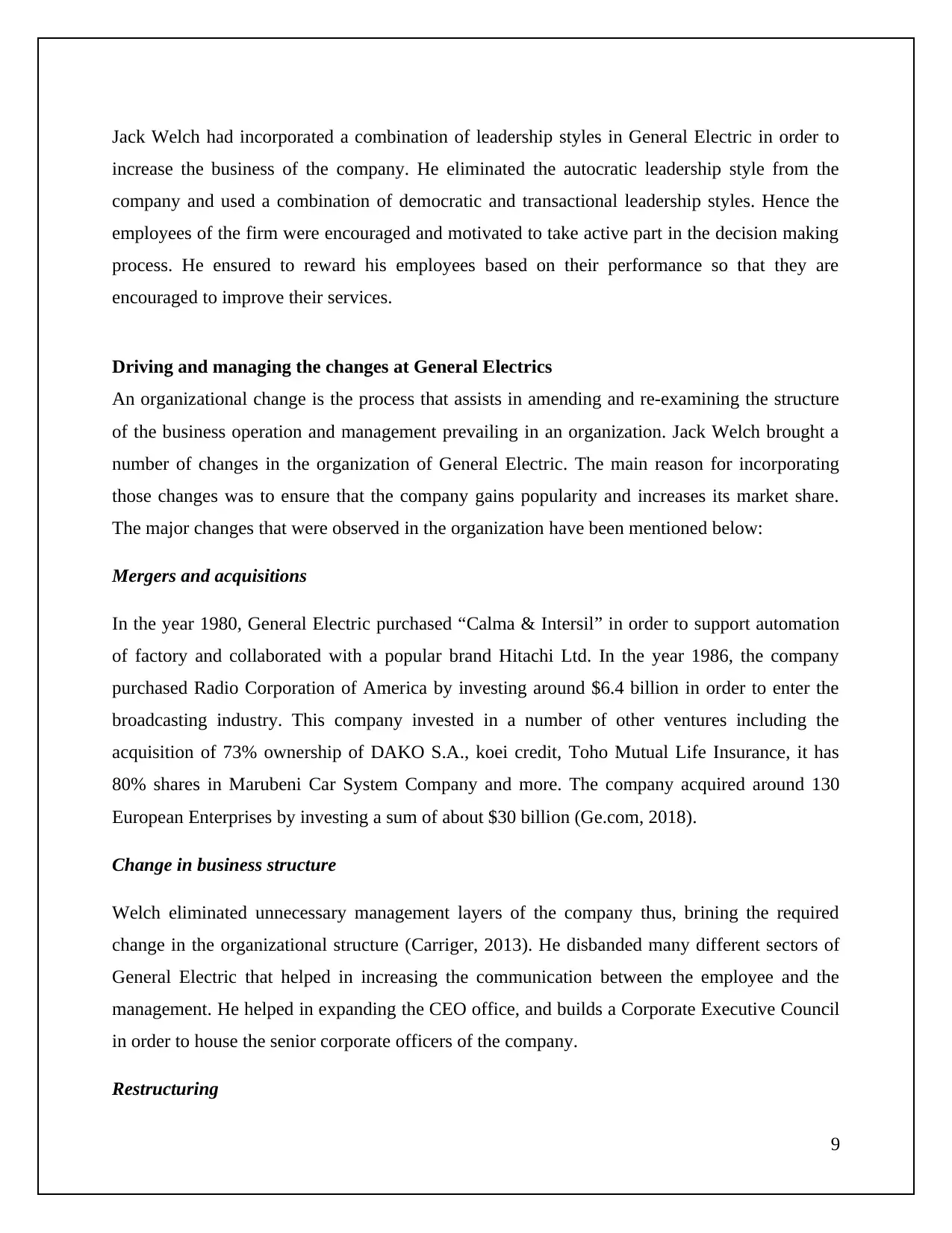
Jack Welch had incorporated a combination of leadership styles in General Electric in order to
increase the business of the company. He eliminated the autocratic leadership style from the
company and used a combination of democratic and transactional leadership styles. Hence the
employees of the firm were encouraged and motivated to take active part in the decision making
process. He ensured to reward his employees based on their performance so that they are
encouraged to improve their services.
Driving and managing the changes at General Electrics
An organizational change is the process that assists in amending and re-examining the structure
of the business operation and management prevailing in an organization. Jack Welch brought a
number of changes in the organization of General Electric. The main reason for incorporating
those changes was to ensure that the company gains popularity and increases its market share.
The major changes that were observed in the organization have been mentioned below:
Mergers and acquisitions
In the year 1980, General Electric purchased “Calma & Intersil” in order to support automation
of factory and collaborated with a popular brand Hitachi Ltd. In the year 1986, the company
purchased Radio Corporation of America by investing around $6.4 billion in order to enter the
broadcasting industry. This company invested in a number of other ventures including the
acquisition of 73% ownership of DAKO S.A., koei credit, Toho Mutual Life Insurance, it has
80% shares in Marubeni Car System Company and more. The company acquired around 130
European Enterprises by investing a sum of about $30 billion (Ge.com, 2018).
Change in business structure
Welch eliminated unnecessary management layers of the company thus, brining the required
change in the organizational structure (Carriger, 2013). He disbanded many different sectors of
General Electric that helped in increasing the communication between the employee and the
management. He helped in expanding the CEO office, and builds a Corporate Executive Council
in order to house the senior corporate officers of the company.
Restructuring
9
increase the business of the company. He eliminated the autocratic leadership style from the
company and used a combination of democratic and transactional leadership styles. Hence the
employees of the firm were encouraged and motivated to take active part in the decision making
process. He ensured to reward his employees based on their performance so that they are
encouraged to improve their services.
Driving and managing the changes at General Electrics
An organizational change is the process that assists in amending and re-examining the structure
of the business operation and management prevailing in an organization. Jack Welch brought a
number of changes in the organization of General Electric. The main reason for incorporating
those changes was to ensure that the company gains popularity and increases its market share.
The major changes that were observed in the organization have been mentioned below:
Mergers and acquisitions
In the year 1980, General Electric purchased “Calma & Intersil” in order to support automation
of factory and collaborated with a popular brand Hitachi Ltd. In the year 1986, the company
purchased Radio Corporation of America by investing around $6.4 billion in order to enter the
broadcasting industry. This company invested in a number of other ventures including the
acquisition of 73% ownership of DAKO S.A., koei credit, Toho Mutual Life Insurance, it has
80% shares in Marubeni Car System Company and more. The company acquired around 130
European Enterprises by investing a sum of about $30 billion (Ge.com, 2018).
Change in business structure
Welch eliminated unnecessary management layers of the company thus, brining the required
change in the organizational structure (Carriger, 2013). He disbanded many different sectors of
General Electric that helped in increasing the communication between the employee and the
management. He helped in expanding the CEO office, and builds a Corporate Executive Council
in order to house the senior corporate officers of the company.
Restructuring
9
⊘ This is a preview!⊘
Do you want full access?
Subscribe today to unlock all pages.

Trusted by 1+ million students worldwide
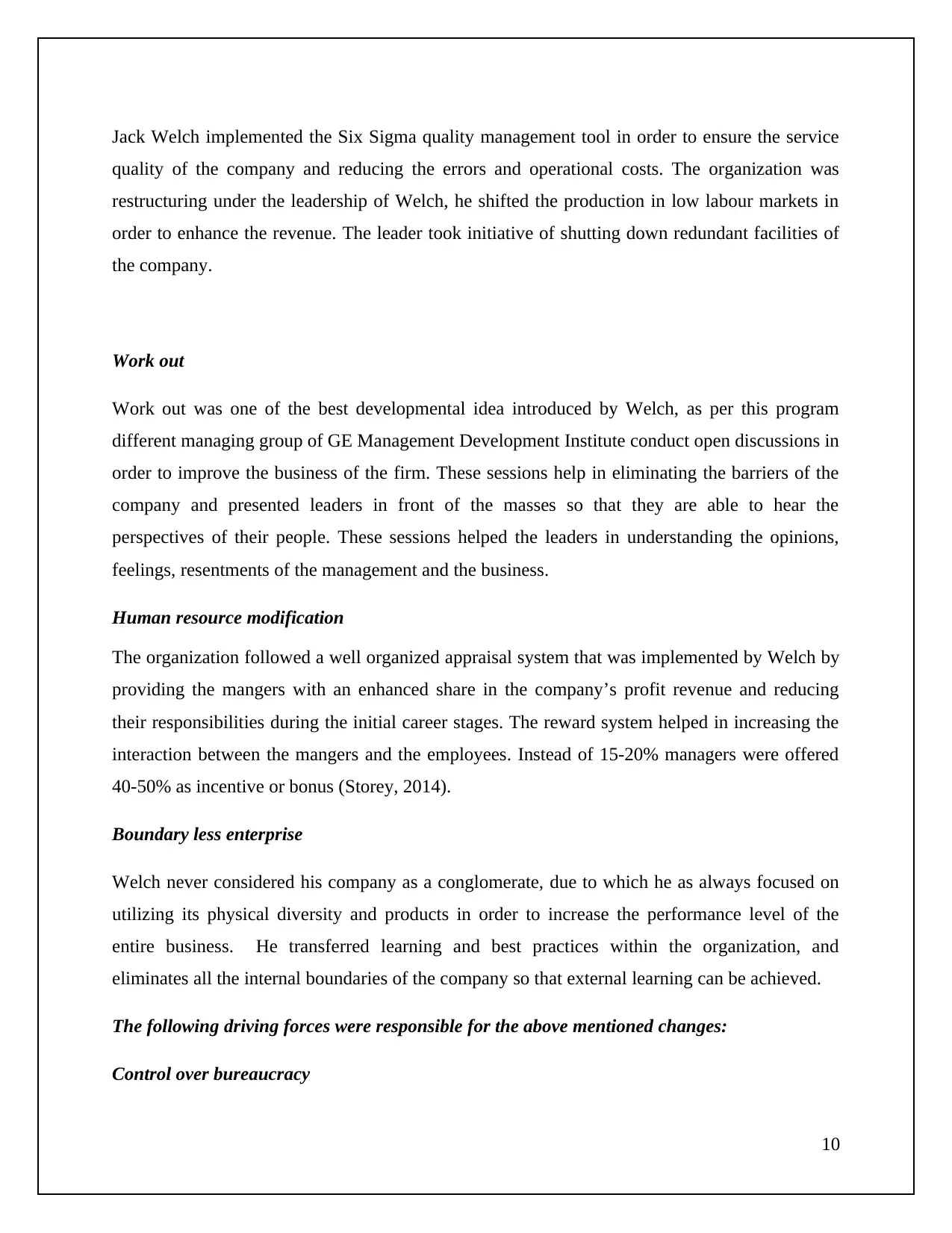
Jack Welch implemented the Six Sigma quality management tool in order to ensure the service
quality of the company and reducing the errors and operational costs. The organization was
restructuring under the leadership of Welch, he shifted the production in low labour markets in
order to enhance the revenue. The leader took initiative of shutting down redundant facilities of
the company.
Work out
Work out was one of the best developmental idea introduced by Welch, as per this program
different managing group of GE Management Development Institute conduct open discussions in
order to improve the business of the firm. These sessions help in eliminating the barriers of the
company and presented leaders in front of the masses so that they are able to hear the
perspectives of their people. These sessions helped the leaders in understanding the opinions,
feelings, resentments of the management and the business.
Human resource modification
The organization followed a well organized appraisal system that was implemented by Welch by
providing the mangers with an enhanced share in the company’s profit revenue and reducing
their responsibilities during the initial career stages. The reward system helped in increasing the
interaction between the mangers and the employees. Instead of 15-20% managers were offered
40-50% as incentive or bonus (Storey, 2014).
Boundary less enterprise
Welch never considered his company as a conglomerate, due to which he as always focused on
utilizing its physical diversity and products in order to increase the performance level of the
entire business. He transferred learning and best practices within the organization, and
eliminates all the internal boundaries of the company so that external learning can be achieved.
The following driving forces were responsible for the above mentioned changes:
Control over bureaucracy
10
quality of the company and reducing the errors and operational costs. The organization was
restructuring under the leadership of Welch, he shifted the production in low labour markets in
order to enhance the revenue. The leader took initiative of shutting down redundant facilities of
the company.
Work out
Work out was one of the best developmental idea introduced by Welch, as per this program
different managing group of GE Management Development Institute conduct open discussions in
order to improve the business of the firm. These sessions help in eliminating the barriers of the
company and presented leaders in front of the masses so that they are able to hear the
perspectives of their people. These sessions helped the leaders in understanding the opinions,
feelings, resentments of the management and the business.
Human resource modification
The organization followed a well organized appraisal system that was implemented by Welch by
providing the mangers with an enhanced share in the company’s profit revenue and reducing
their responsibilities during the initial career stages. The reward system helped in increasing the
interaction between the mangers and the employees. Instead of 15-20% managers were offered
40-50% as incentive or bonus (Storey, 2014).
Boundary less enterprise
Welch never considered his company as a conglomerate, due to which he as always focused on
utilizing its physical diversity and products in order to increase the performance level of the
entire business. He transferred learning and best practices within the organization, and
eliminates all the internal boundaries of the company so that external learning can be achieved.
The following driving forces were responsible for the above mentioned changes:
Control over bureaucracy
10
Paraphrase This Document
Need a fresh take? Get an instant paraphrase of this document with our AI Paraphraser
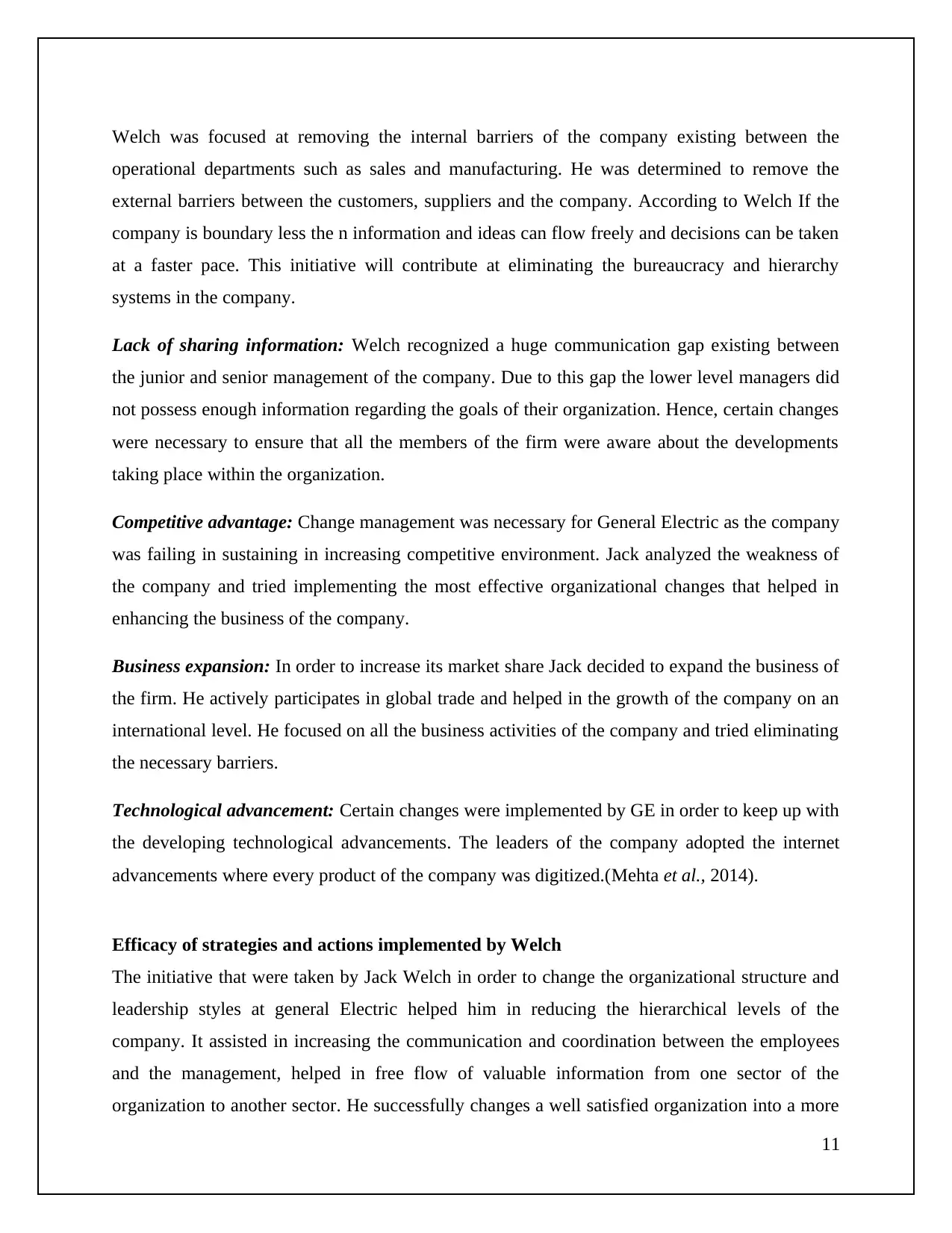
Welch was focused at removing the internal barriers of the company existing between the
operational departments such as sales and manufacturing. He was determined to remove the
external barriers between the customers, suppliers and the company. According to Welch If the
company is boundary less the n information and ideas can flow freely and decisions can be taken
at a faster pace. This initiative will contribute at eliminating the bureaucracy and hierarchy
systems in the company.
Lack of sharing information: Welch recognized a huge communication gap existing between
the junior and senior management of the company. Due to this gap the lower level managers did
not possess enough information regarding the goals of their organization. Hence, certain changes
were necessary to ensure that all the members of the firm were aware about the developments
taking place within the organization.
Competitive advantage: Change management was necessary for General Electric as the company
was failing in sustaining in increasing competitive environment. Jack analyzed the weakness of
the company and tried implementing the most effective organizational changes that helped in
enhancing the business of the company.
Business expansion: In order to increase its market share Jack decided to expand the business of
the firm. He actively participates in global trade and helped in the growth of the company on an
international level. He focused on all the business activities of the company and tried eliminating
the necessary barriers.
Technological advancement: Certain changes were implemented by GE in order to keep up with
the developing technological advancements. The leaders of the company adopted the internet
advancements where every product of the company was digitized.(Mehta et al., 2014).
Efficacy of strategies and actions implemented by Welch
The initiative that were taken by Jack Welch in order to change the organizational structure and
leadership styles at general Electric helped him in reducing the hierarchical levels of the
company. It assisted in increasing the communication and coordination between the employees
and the management, helped in free flow of valuable information from one sector of the
organization to another sector. He successfully changes a well satisfied organization into a more
11
operational departments such as sales and manufacturing. He was determined to remove the
external barriers between the customers, suppliers and the company. According to Welch If the
company is boundary less the n information and ideas can flow freely and decisions can be taken
at a faster pace. This initiative will contribute at eliminating the bureaucracy and hierarchy
systems in the company.
Lack of sharing information: Welch recognized a huge communication gap existing between
the junior and senior management of the company. Due to this gap the lower level managers did
not possess enough information regarding the goals of their organization. Hence, certain changes
were necessary to ensure that all the members of the firm were aware about the developments
taking place within the organization.
Competitive advantage: Change management was necessary for General Electric as the company
was failing in sustaining in increasing competitive environment. Jack analyzed the weakness of
the company and tried implementing the most effective organizational changes that helped in
enhancing the business of the company.
Business expansion: In order to increase its market share Jack decided to expand the business of
the firm. He actively participates in global trade and helped in the growth of the company on an
international level. He focused on all the business activities of the company and tried eliminating
the necessary barriers.
Technological advancement: Certain changes were implemented by GE in order to keep up with
the developing technological advancements. The leaders of the company adopted the internet
advancements where every product of the company was digitized.(Mehta et al., 2014).
Efficacy of strategies and actions implemented by Welch
The initiative that were taken by Jack Welch in order to change the organizational structure and
leadership styles at general Electric helped him in reducing the hierarchical levels of the
company. It assisted in increasing the communication and coordination between the employees
and the management, helped in free flow of valuable information from one sector of the
organization to another sector. He successfully changes a well satisfied organization into a more
11
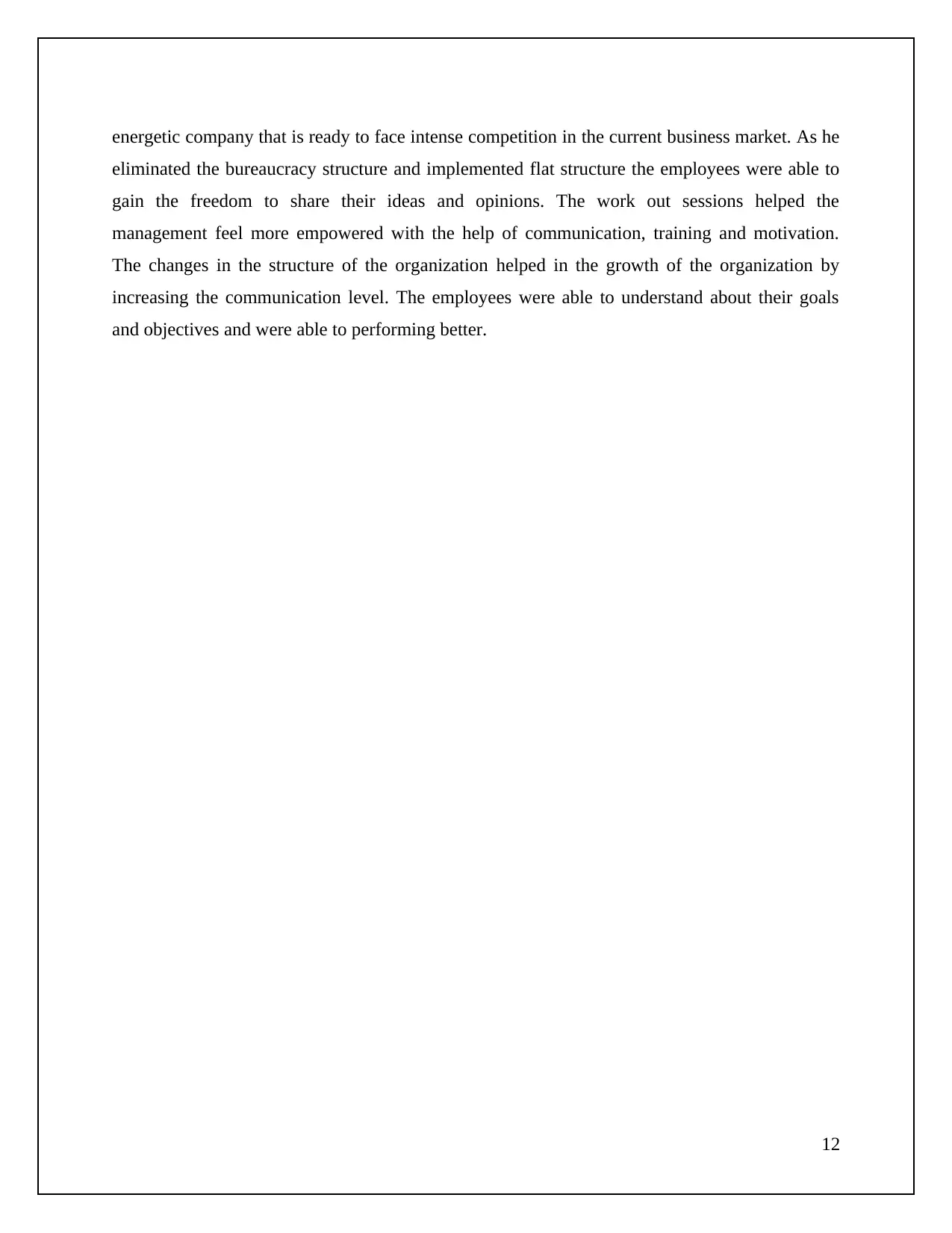
energetic company that is ready to face intense competition in the current business market. As he
eliminated the bureaucracy structure and implemented flat structure the employees were able to
gain the freedom to share their ideas and opinions. The work out sessions helped the
management feel more empowered with the help of communication, training and motivation.
The changes in the structure of the organization helped in the growth of the organization by
increasing the communication level. The employees were able to understand about their goals
and objectives and were able to performing better.
12
eliminated the bureaucracy structure and implemented flat structure the employees were able to
gain the freedom to share their ideas and opinions. The work out sessions helped the
management feel more empowered with the help of communication, training and motivation.
The changes in the structure of the organization helped in the growth of the organization by
increasing the communication level. The employees were able to understand about their goals
and objectives and were able to performing better.
12
⊘ This is a preview!⊘
Do you want full access?
Subscribe today to unlock all pages.

Trusted by 1+ million students worldwide
1 out of 16
Related Documents
Your All-in-One AI-Powered Toolkit for Academic Success.
+13062052269
info@desklib.com
Available 24*7 on WhatsApp / Email
![[object Object]](/_next/static/media/star-bottom.7253800d.svg)
Unlock your academic potential
Copyright © 2020–2025 A2Z Services. All Rights Reserved. Developed and managed by ZUCOL.




